Multilingual surveys in SurveyMR 2.0
Multilingual surveys allow you to programme a survey in multiple languages. For example, to programme a survey that is available to respondents in both English and Spanish.
What are Multilingual surveys?
Multilingual surveys have a programming language, such as English. The programming language is the language that you build the survey in initially. It is also the languages in which you will see the results in if you export the survey with the question-and-answer labels. Following this, you can upload additional language versions of the survey as required.
Important: Before you can programme a multilingual survey, you will need to first ensure that Internationalisation is switched on for your InsightHub. This is an additional feature that we offer. Please contact the FlexMR Client Support team on support@flexmr.net to find out more.
How to create a new Multilingual survey
- First, go to create a SurveyMR 2.0 via back room > research tools > SurveyMR 2.0. Then, click on the + Add SurveyMR 2.0 button in the top right corner.
- In the pop-up window, give your survey a name, internal name (optional), then set the programming language from the ‘Primary Language’ drop down menu.
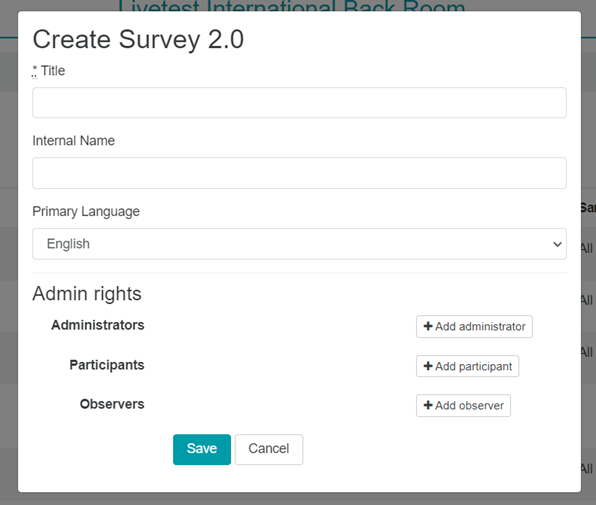
- This drop-down menu will show all of the languages that are setup in your InsightHub.
- Select your preferred primary language from the drop-down menu, then click Ok.
- Once created, you will notice there is a new ‘tab’ in your survey, called ‘Languages'
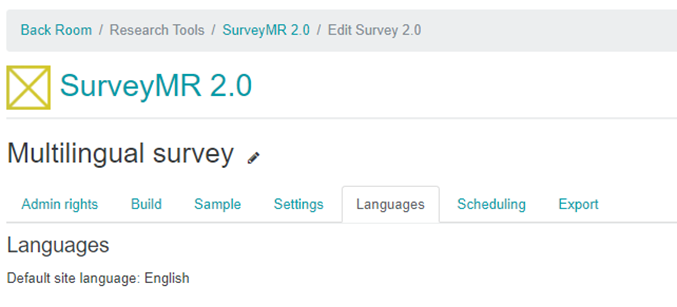
-
The Languages tab is where you import different translations of your questions into your survey.
In this tab, you will first see the ‘Survey programming language’. Below this, you will see a list of any other languages currently enabled on your Insight Hub’s Internationalisation settings.
Please see each of the options explained below the labelled screenshot below:
‘Add’ – click on the + symbol to add this language to your survey
‘Make Programming Language’ – click on the star icon to change the programming language of your survey
‘Show to respondents’ – Shows if the language is set to show to respondents or not. To update this, click on the Actions drop down menu and ‘show to respondents’ or ‘Hide from respondents’
‘Translate Title’ – If you have added different languages to your survey, ensure to set a translated title for that language. Click on the + symbol to set a translated title.
‘Actions’ – The actions drop down menu has different options, including; test the survey, export the survey, import survey translations, hide from respondents, remove language from survey.
To add a new language to your survey, first you need to export the primary survey translations. This exports into an excel file. To do this, by your survey programming language, click on actions > export primary survey text: 
7. Save the file down, then open the file in excel. The file will look like this:
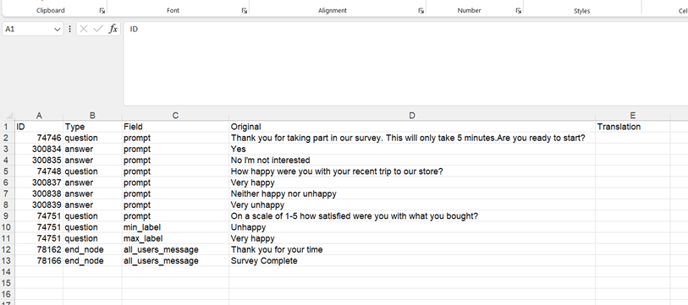
8. The only column that should be updated is column E, where you can enter the translation for what is showing in column D. You do not need to edit any of the other columns in the file.
- Column A – Contains the ID for the survey element
- Column B – Contains the type of survey element
- Column C – Contains the survey element field
- Column D – Contains the Original survey programming language text that was added in your survey build tab. (If you do need to edit anything in this column, please do not edit this in the export file. Instead, go back to your InsightHub surveys’ ‘build’ tab, edit the element on here, then re-export the primary survey text, and open this updated file)
- Column E – This is where you need to input your survey translations in the language required. In the example shown in the screenshots, the translations will be added in German as this is the language being imported in this example.
9. Once you have add your translations into Column E, save the file, labelling it with the language. E.g., ‘german_survey_translations’

10. Next, you need to import your survey translations. To do this, return back to your InsightHub surveys’ ‘languages’ tab, then find the language that you need to import translations for. Click on the ‘+’ symbol underneath the ‘Add’ column. Click ‘Ok’ in the pop-up box.
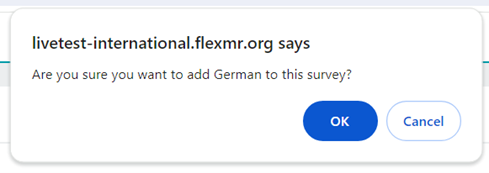
11. Once added, the language becomes bold in the list, and you will see the ‘actions’ drop-down menu will appear alongside this language.

12. Click on the actions drop down arrow. Then, click on ‘Import survey translations;
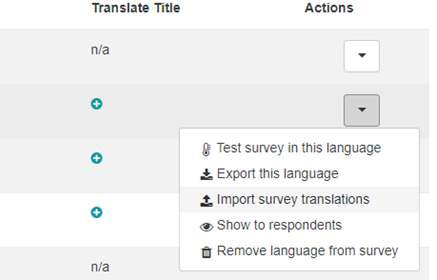
13. Next, select your translations file and click ‘Import’

14. Once you have clicked import, you will see a banner message appear saying ‘Successfully scheduled import of ______ translations to this survey. Please check the waiting room to view the progress of this import’.
15. You can then go to the waiting room. If you refresh your browser tab, you will see a sand timer icon in the top right-hand corner of the screen:


16. Click on this to go to the waiting room. Once your translations import is complete, you will see this in the ‘complete’ tab as below:

17. Once imported successfully, return back to your surveys’ ‘languages’ tab. Here you can test the survey in the language you imported. Go to actions > ‘Test survey in this language’.

Setting a Multilingual survey live
Once you have thoroughly tested your Multilingual survey, it’s time to set it live.
In the ‘languages’ tab for your survey, you first need to:
- Ensure that your language is set to ‘Show to respondents’. You can do this by clicking on the actions drop down menu > then select ‘show to respondents. This means that the survey will be visible/accessible in this language. To hide a language from respondents, go to actions and click ‘Hide from respondents’
- Ensure that you set a translated title for the languages in your survey. This will be the title the participant sees if they take the survey in that language. To do this, click on the ‘+’ symbol underneath the ‘Translate Title’ column:

- Decide if you would like respondents to be able to choose which language they complete the survey in. If you would like respondents to be able to select their language at the beginning of a survey, ensure to tick ‘Let respondent select language’ at the bottom of the page, then click ‘Apply’. When this option is ticked, it means the respondent can select any language that you have imported into your survey.

Selecting a sample for a Multilingual survey
Once you have set all the required settings as above, you can then decide how you would like to send out your Multilingual survey.
First, click on the ‘Sample’ tab.
Here, you have each of the sample options, including Internal users, Open link, Embedded Survey, and Upload a CSV.
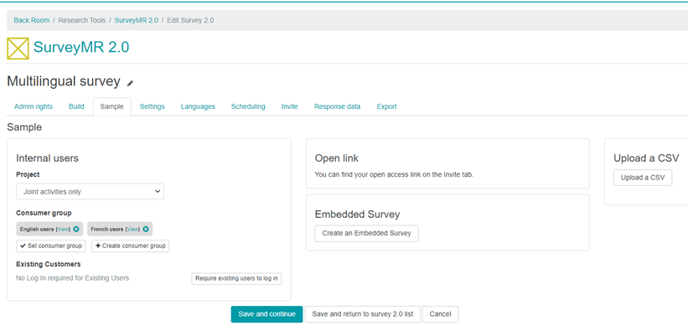
Once you have assigned your sample, go to the ‘Invite’ tab. Here you will see the options to invite users, based on which sample option you selected.
‘Internal users’ - select the relevant project and consumer group. For example, you may have a project set up for each language. Furthermore, there is the option to invite individual consumer groups to the survey which will allow you to send out invites in each different language.
‘Open link’ - the open access link for the survey will be available in the ‘Invite’ tab once you have set the survey live. To note, there will be a separate open link for each language that you have programmed.
'Upload a CSV' - You can upload a CSV sample to a Multilingual survey. Click on 'Upload a CSV' then choose the file from your folders. Ensure
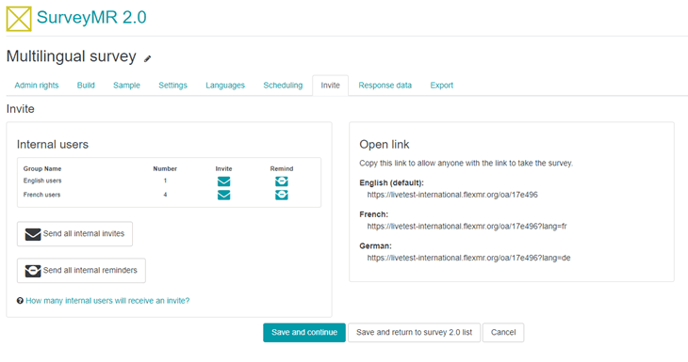
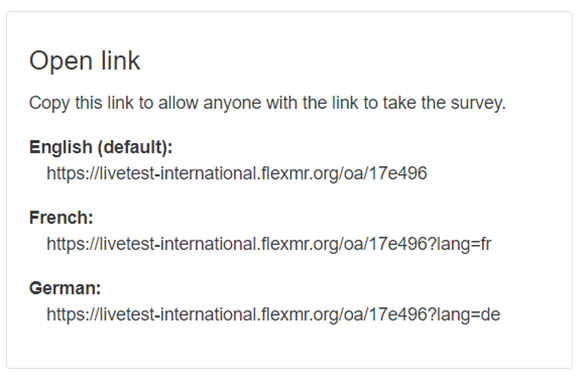
Multilingual survey results
Exporting the survey data
To view the raw data results for your survey, go to the ‘export’ tab. Take an export in the format that you need.
Then, open the export in excel. Once you have done this you will be able to view the results of your survey as usual. To note, the results of the survey such as question and answer codes will appear in the ‘Survey Programming Language’. For example, if your survey programming language is English, the results will all show in English. (Aside from any open text questions or custom answers, which will show in the language they were input by the respondent).
Good to know: You can also view which language a user took the survey in via the column at the end of the export file with the header ‘Language’.
Viewing the results in NumbersMR
When you view the results of a Multilingual survey in NumbersMR, there is an option to generate a ‘Language frequency table’. In this Frequency table, the Languages programmed into your survey (in the Languages tab of the survey) will show in the table, allowing you to view the results of a question based on language.
 Summary
Summary
Multilingual surveys allow you to programme multiple languages into one given survey. They also provide one single data output. This avoids the need to programme multiple surveys/ multiple outputs.
If you have any questions, please get in touch with our Client Support Desk team on support@flexmr.net.